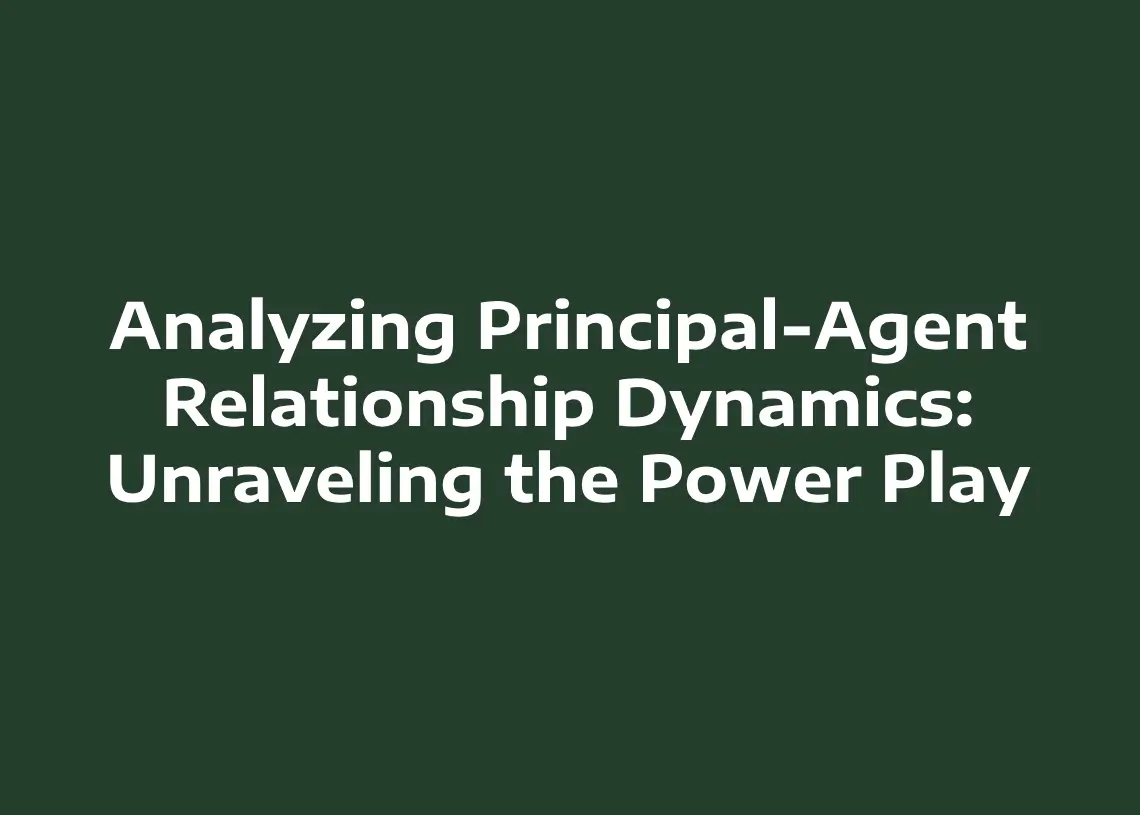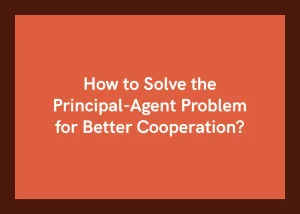In today’s fast-paced business world, the principal-agent relationship is a critical component of organizational success. Regardless of industry or sector, companies must navigate complex relationships between decision-makers (principals) and those who implement those decisions (agents) to achieve their goals. Yet, understanding the dynamics of this relationship is often easier said than done.
In this blog post, we will explore the complexities of the principal-agent relationship and how to analyze its dynamics. At the heart of the principal-agent relationship lies a fundamental problem: the principal wishes to achieve certain outcomes, but cannot directly control the actions of the agent. This creates what economists call an “agency problem,” where the interests of the principal and agent are not always aligned.
As a result, principals may need to use incentives or other mechanisms to ensure that agents pursue goals that are in line with the organization’s objectives. To fully comprehend the dynamics of the principal-agent relationship, we will examine a range of factors, including the role of information.
Understanding principal-agent relationship dynamics
Analyzing Principal-Agent Relationship Dynamics is a critical task for any organization that wishes to optimize its efficiency and productivity. At its core, the principal-agent relationship is a contractual agreement between two parties, where one (the principal) hires the other (the agent) to act on their behalf.
This relationship is ubiquitous in the business world, where principals rely on agents to carry out tasks on their behalf. However, the dynamics of this relationship can be complex, with agents often having their own interests and incentives that may not align with those of their principals.
Understanding Principal-Agent Relationship Dynamics is therefore essential for organizations to ensure that their agents act in their best interests, and that the relationship remains mutually beneficial. In this document, we will examine the various factors that influence Principal-Agent Relationship Dynamics, and provide recommendations for organizations to optimize this relationship for maximum efficiency.
Earn a certificate in your dream career for an affordable price at IAP Career College today!
Importance of communication and trust
Effective communication and trust are essential components of successful principal-agent relationship dynamics. The relationship between a principal and an agent is often characterized by information asymmetry, where the principal has limited knowledge of the agent’s actions and performance.
Clear and frequent communication between the two parties can help to mitigate this information gap, ensuring that the principal is kept informed of the agent’s actions and progress towards shared goals. Additionally, trust is crucial in building a strong relationship between the principal and agent.
When the principal trusts the agent to act in their best interests, they are more likely to delegate tasks and responsibilities to the agent. This, in turn, can lead to increased efficiency and productivity. Conversely, a lack of trust can lead to micromanagement and reduced autonomy, negatively impacting the relationship and overall outcomes. Therefore, effective communication and trust are critical factors in maintaining a positive and productive principal-agent relationship.
How incentives affect behavior
In analyzing principal-agent relationship dynamics, one important factor to consider is how incentives affect behavior. Incentives, which can be positive or negative, are designed to motivate an agent to act in a way that is aligned with the principal’s objectives.
Positive incentives, such as bonuses or rewards, can increase an agent’s motivation to work harder and achieve better results. On the other hand, negative incentives, such as penalties or fines, can discourage an agent from engaging in undesirable behavior.
It is important for principals to carefully consider the type of incentive they offer to ensure that it is well-aligned with their objectives and that it will motivate the agent(s) to act in the desired way. Ultimately, a well-designed incentive system can help to strengthen the principal-agent relationship and improve overall performance.
Balancing control and autonomy
In analyzing principal-agent relationship dynamics, it is important to consider the balance between control and autonomy. On one hand, principal’s desire for control and oversight is understandable, given their vested interest in the outcome of the agent’s work.
However, excessive control can lead to a lack of autonomy for the agent, potentially resulting in reduced motivation and productivity. On the other hand, granting too much autonomy to the agent can result in a lack of accountability and potentially suboptimal outcomes.
Finding the right balance between control and autonomy requires clear communication, well-defined goals and expectations, regular monitoring, and appropriate incentives and rewards. Ultimately, a successful principal-agent relationship depends on establishing trust and open communication, while ensuring that both parties feel valued and respected.
Aligning goals and objectives
In order to effectively manage Principal-Agent Relationship Dynamics, it is crucial to align the goals and objectives of all parties involved. This involves setting clear and measurable targets that are mutually agreed upon, and regularly reviewing progress towards these targets.
By aligning goals and objectives, all parties can work towards a common purpose, reducing the potential for conflict and increasing the likelihood of success. This process requires effective communication and collaboration, and may involve negotiation to ensure that each party’s priorities are adequately addressed. Ultimately, aligning goals and objectives is critical to building trust and ensuring that all parties are working towards the same end goal.
Managing information asymmetry
Information asymmetry is a common issue that arises in principal-agent relationship dynamics. It occurs when one party has more information or knowledge about a particular situation than the other, leading to a power imbalance.
Managing information asymmetry is crucial in these relationships to promote trust, fairness, and effective communication. One way to address this issue is through transparency. The principal should provide the agent with relevant information and data needed to make informed decisions while also encouraging the sharing of information from the agent’s side.
Another strategy is to establish clear guidelines and expectations from both parties to ensure that all necessary information is disclosed during the relationship. Additionally, a third-party mediator or auditor can be involved to ensure that both parties adhere to the agreed-upon rules and that the principal-agent relationship remains equitable and productive. Overall, effective management of information asymmetry is essential to maintain a healthy and productive principal-agent relationship dynamic.
Handling conflicts and disputes
One of the most critical aspects of Principal-Agent Relationship Dynamics is handling conflicts and disputes. Conflicts may arise between the principal and agent due to differing interests, goals, or miscommunication. Effective conflict management is crucial for maintaining a productive and successful relationship.
When conflicts arise, both parties should engage in a respectful and honest dialogue to understand the root causes of the conflict and work towards a mutually beneficial solution. It is also important to establish clear communication channels and protocols for resolving disputes to avoid misunderstandings and tensions.
Conflict resolution techniques, such as mediation or negotiation, may also be employed to reach a satisfactory resolution. By proactively addressing conflicts and disputes, the principal-agent relationship can be strengthened, leading to improved performance and outcomes.
Evaluating performance and outcomes
One of the crucial components of analyzing Principal-Agent Relationship Dynamics is evaluating the performance and outcomes of the relationship. This involves assessing whether the agent has fulfilled their obligations and achieved the predetermined goals set by the principal.
The principal must establish clear expectations and performance metrics for the agent to ensure that they are meeting their responsibilities. The evaluation process should be well-documented and transparent, allowing for both parties to review the results and provide feedback.
It is also important to consider any external factors that may have impacted the outcomes, as this can affect the overall success of the relationship. Through careful evaluation of performance and outcomes, the principal can identify areas for improvement and make necessary adjustments to optimize the relationship.
Building strong partnerships over time
In analyzing principal-agent relationship dynamics, building strong partnerships over time is a critical aspect that cannot be overlooked. These relationships are often complex and can be influenced by a variety of factors, including conflicting interests and different goals.
However, when both parties are committed to investing the time and effort required to build trust and cooperation, the benefits of a strong partnership are numerous. Effective communication, mutual understanding, and a willingness to collaborate are key components of successful principal-agent relationships.
By prioritizing these factors, parties can establish a foundation of trust, increase transparency, and ultimately achieve better outcomes. Building a strong partnership takes time and effort, but the rewards are worth it in the long run.
Continuously improving the relationship.
Principal-agent relationship dynamics are complex and require attention to detail to be successful. One key aspect to consider is continuously improving the relationship between the principal and the agent. This can be done through open and honest communication, setting clear expectations, and providing regular feedback.
When both parties feel heard and valued, it can increase trust and lead to better performance. It’s also important to address any issues or conflicts in a timely and respectful manner to prevent them from escalating. By prioritizing the relationship and making efforts to improve it, the principal and agent can work together more effectively towards their common goals.
Conclusion: Analyzing Principal-Agent Relationship Dynamics
In conclusion, analyzing the dynamics of principal-agent relationship is crucial for organizations to achieve their goals and objectives. A better understanding of these dynamics can help organizations design effective incentive schemes, performance evaluation systems, and control mechanisms that align the interests of agents with those of principals.
While there are challenges in identifying and managing these dynamics, it is important for organizations to invest in building trust and communication between principals and agents. By doing so, organizations can create a conducive environment for mutual cooperation and achieve their desired outcomes.





